Connecting with Shawn Green through his baseball cards
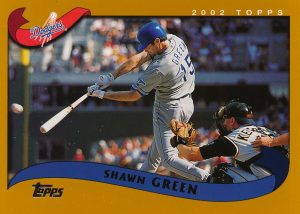
Imagine returning to a childhood hobby collecting baseball cards with the goal of connecting with a single Jewish player.
For me, that player was Shawn Green.
In 1993 I returned to the adventure of collecting cards, with the joy of reading the back of the cards to find out more about Shawn and admiring the picture provided on the front.
Everyone had a reason for collecting when growing up. For me it was reading the backs of cards, sharing the information with friends and trading the cards if we had doubles.
The inspiration to return to baseball cards is when my mom mailed me an article about Shawn that appeared in a local Jewish publication, along with a note reminding me that I had baseball cards at her house. Maybe this was a subtle hint that she wanted the cards out of the house.
Having big dreams in 1993, I started collecting with the innocent goal of getting every Shawn Green card. In 1992 there were only 12 baseball cards released, and in 1993 that number decreased to three. Collecting was going to be easy — maybe there would be 200-400 cards based on the number of cards printed in the 1980s and early ‘90s.
It seemed a simple task in 1993 because Shawn Green was just starting off in baseball and there were lots of local card shows with dealers opening packs for me. All I had to do was ask if they had any Shawn Green cards. Most card dealers were excited to sell me the card. Paying $1 or $2 for a card was a simple choice versus paying the same amount not knowing if a Green card was in a full pack.
When I returned to collecting, I also factored in the career of baseball players since the major league draft began in 1965 and I assumed Green’s career would span a maximum of 10 years like Ken Holtzman and Steve Stone. Jewish players drafted in the 1980s, such as Steve Wapnick and Eddie Zosky, sadly had short careers.
The number of cards produced over the years took the shape of a bell curve as a reflection of each of Shawn’s teams, helping to divide his career into four separate phases. His journey reminded me of the Thomas Cole Voyage of Life paintings, displayed in the National Gallery of Art, that represent a long baseball career starting with Childhood (minors), Youth (Blue Jays), Manhood (Dodgers) and Old Age (Diamondbacks and Mets).
Cards released after Shawn retired are not part of the voyage that followed his baseball career (more like the afterlife).
Using the www.beckett.com cards search feature “Shawn Green baseball” resulted in 4,655 (-50 for outliners) cards (as of February 2024) that have been released. This is not a true number of unique cards — there is a lot of overlap in the types of cards because of the parallel card concept, but the writing on the backs was identical.
A lot about collecting had changed. There are multiple card companies releasing different bands and packets. Random packs can include possible game-used items or a company-certified autograph card of the player. Below is a breakdown of the number of Green cards released during each of the phases (including retirement as the afterlife):
Minor league 1992-1994 50
Blue Jays 1995-1999 448
Dodgers 2000-2004 3399
Diamondbacks/Mets 301
Since retirement (through March 2024) 352
I followed Shawn’s journey through baseball by reading the backs of the cards, hoping for a reference to Shawn’s Jewish heritage. After adding a few cards to my collection, I quickly learned that Shawn was a good player in high school, along with being a good student and was tall, without ever meeting him. 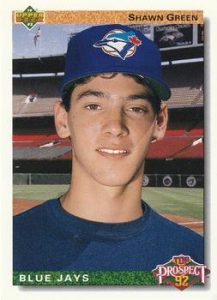
The first card in my collection was the 1992 Upper Deck (card #55) and the back indicated that “the Blue Jays spent $700,000, the second-highest bonus in baseball history, to sign Green.
“The first-round pick graduated second in his class Tustin (Calif.) High School with a grade-point average in excess of 4.0. He signed after Toronto agreed to allow him to attend Stanford University in the fall and spring while missing instructional league and part of spring training each year.
“He led the United States Junior Team with a .436 batting average and then batted .474 with two home runs and 30 RBIs his senior season at Tustin.
“The Blue Jays envision Green developing into a consistent .300 hitter with power and he has an excellent arm and outstanding range in the outfield. He also has the speed to develop into an above-average runner but needs work on the basepaths.”
The 1992 Classic 4 sport card included: “Toronto’s first selection and the 16th overall in the June draft, Shawn was named 1991 Orange County Player of the Year by the Los Angeles Times and earned All-CIF first-team honors in both 1992 and 1991. By practicing daily in his own batting cage at home, Green has established himself as a terrific contact hitter, striking out only once in 76 at-bats this season.”
Tracking Shawn’s rise through the minors also reinforced that he would be part of the Blue Jays. Reading the backs of cards from 1992-95 provided a more colorful input of his potential into making it to MLB.
Two 1994 cards that supported this:
1994 Bowman (#253) — “A magnificent throwing arm from right field is Green’s most attention-grabbing tool, but a silky swing (in the mold of John Olerud) has the Blue Jays thinking ‘star.’ A brilliant HS student, he was signed out of the clutches of Stanford.”
1994 Upper Deck (#15) — “A possible five-tool player with a swing that draws comparisons to John Olerud, Shawn Green has been playing catch-up after signing with the Blue Jays as a first-round pick in 1991. Green didn’t debut professionally until 1992, when he batted .273 with 22 steals for Class-A Dunedin. His 1993 numbers included a .340 batting average at home. Another strong point of his game is his phenomenal arm, and the Blue Jays needn’t worry about his attitude, either. Green is already accustomed to winning, having contributed to division-winners each of his first two seasons.”
Shawn Green made the cover of Baseball America publication announcing that he won the batting title in 1994 (https://www.gumtree.com.au/s-ad/angle-park/collectables/baseball-america-october-30-1994-cover-shawn-green-toronto/1300604629) with the Syracuse Chiefs. It seemed that in 1995 he would be called up to the Blue Jays — either as a bench outfielder for players that have a history of batter/pitchers that struggle with left-handed batters or as a regular outfielder.
The year 1995 also was the first appearance of a Green insert card, a notice to collectors that there is a new star in the making. For the people collecting Jewish baseball players, the insert card also represented the hope that some card would include a reference to Sandy Koufax or Hank Greenberg to create some excitement about him being immortalized in the National Baseball Hall of Fame.
Upon his arrival in 1995 to the Blue Jays the writing on the back of the cards started referencing his accomplishments in the minors, hinting to Shawn’s potential future contributions to the Blue Jays.
1995 Upper Deck SP Champion (#199) — “Green hit in 83 of 109 games for Class-AAA Syracuse in 1994 to finish at .344 and become the third Syracuse player to bring home a batting crown. For his efforts, Green was named International League’s Rookie of the Year for 1994.”
1996 Fleer Insert (6 of 15) — “A steadying, young influence on a team in transition, Shawn Green produced consistently all year for the Toronto Blue Jays. A Triple-A International League batting title winner in 1994, Green stepped right up to the plate in the majors, finishing third on the Jays with a .288 average in ‘95. He also hit 15 dingers and put together a club-high .509 slugging percentage.”
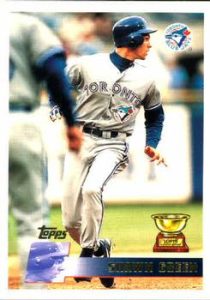
1996 Topps (#417) — “Shawn’s first full season in 1995 was a disappointment to no one, as he set the Toronto rookie record for extra-base hits (50). ‘The sky’s the limit,’ predicts veteran teammate Joe Carter, who moved from right field to left to open a spot for Green. ‘He’s got speed, the best arm in baseball and a natural swing.’”
1999 Upper Deck Victory (#414) — “After a slow start to his ‘98 season, Green picked it up and tied a club record by homering in four straight games, from 4-5-98 to 4-9-98. And so began his march to a career-best season, in which he became the first player in Blue Jays history to have 30 homers and 30 steals in a season. In addition, Green posted career highs in most categories and led the Blue Jays in hits and runs scored (106).”
Topps Gallery brand consistency provide some colorful comments that showed Shawn had interests outside of baseball.
1999 Gallery (#80) — “Turned down a baseball scholarship to Stanford to sign with Jays…Is subject of a web site where people share their dreams about him…Is ‘intrigued’ by Marilyn Monroe and wants to visit Tibet’s monasteries.”
2000 Gallery (#20) — “Donated much of his signing bonus to a program that feeds needy children…His trade to L.A. allows him to pursue his favorite hobby: surfing…First met Dodger mates when they read Christmas stories to kids together.”
2000 Gallery Exhibits insert (#GE23) — “One feels a surge of energy whenever Green steps to the plate — and the results are often dramatic. In 1998, he stole 35 bases and powered 35 home runs — a number that surged to 42 in ’99. Green has mastered the art of playing right field, nearly reaching perfection in ’99 (one error). The Green exhibit moved to Los Angeles in spring 2000.”
2001 Gallery (#48) — “Played first base as a youth because he threw too hard for other kids to catch…Eats plenty of fish, especially sushi and maki tuna…Has promised $1.5 million to Dodgers Dream Foundation. Also active with Jewish Federation.”
2002 Gallery (#215) — “Played 415 straight games until sitting out on 9/26/2001 in observance of Yom Kippur…Inducted into Southern California Jewish Sports Hall of Fame in Los Angeles…Donates $250,000 per year to charitable Dodgers’ Dream Foundation.”
2003 Gallery (#44) — “Calls former Yankees star Don Mattingly his favorite player as a kid…Opted for baseball career instead of attending Stanford…Says he would have been a doctor if not a baseball player…Enjoys watching Seinfeld re-runs.”
These colorful insights are what attracted me to card collecting. Statistics were fun to analyze, but reading what someone wrote about Shawn seemed to make the card come alive and let my mind flow. Also, with each brand the companies released there was also the excitement of seeing a different picture of Shawn.
Fleer Ultra in 1998 showed Shawn sliding under Cal Ripken and in 1999 being greeted by longtime friend Carlos Delgado. 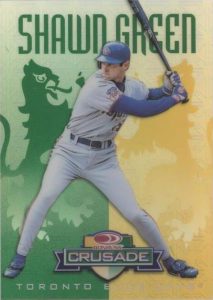
One of the few cards that surprised me was the 1998 Donruss Crusade. The design of the card won me over instantly because it was the first time that I enjoyed the art work used in the background to highlight the picture of the player. Even the back of the crusade card was a joy to read: “Selected 16th overall in the 1991 draft, Shawn blossomed as a player last year. He was the only Blue Jay to homer at least 12 times and steal more than 12 bases.”
In 1997, Donruss released signature cards which included an official autograph. Wow, a card that Shawn Green signed and all I had to do was buy it. The signature card was overlooked by most collectors who were looking for a card that was high in demand such as future HOF candidates.
As a stock purchase, buying the Shawn Green signature card was a long-term investment, but for me it was just another card for my collection. These are just a few of the cards that I kept or admired while collecting Shawn.
On Nov. 8, 1999, the Blue Jays and Dodgers agreed on a trade. This was no surprise to anyone reading the backs of the cards, because most noticed that Shawn was born in Chicago but was raised in Santa Ana, Calif., a suburb of Los Angeles.
The number of cards released from 2000 to 2004 when he was a Dodger felt like a tidal wave with more than 3,300 cards. Most of the cards from the 2000 season showed Shawn as a Dodger, but the backs were still referencing his Blue Jay accomplishments.
One of the first cards to appear in 2000 was the Fleer Tradition (card #250) with a Blue Jay picture of Shawn that read, “No more talk of potential for Shawn, whose monster season in 1999 featured an AL-high 45 doubles and AL top 10 finishes in slugging, hits, homers and RBI.”
Later that year, Fleer Tradition released an updated card (#U86) with a Dodger picture and maybe the first 2000 card that mentioned his impact in Los Angeles: “Shawn hit his third career grand slam May 29, 2000 in the sixth inning off Al Leiter, accounting for all of the Dodgers’ scoring in a 4-1 win over the Mets. He registered his 10th two-homer game in a 7-1 win on April 30.”
Playing for the Dodgers, Shawn’s career started to thrive, and various cards between the period echoed that with statistics and cleverly worded accomplishments.
2001 Fleer Premium Decade of Excellence insert — “Back home in Los Angeles, Green is ready to build on the impressive numbers he put up in Toronto. Power, speed, average – Shawn has it all. Plus, he gives the Dodgers a much-need threat from the left side. Green averaged 39 home runs and 112 RBIs in 1998-99 before joining the Dodgers. Green enjoyed a successful season in 2000, batting .269 with 24 homers and 99 RBIs. He also stole 24 bases. As Green becomes more acclimated with National League pitching, his numbers should skyrocket this decade.”
The back of the 2001 Donruss Crusade insert grabbed your attention by choosing to use all capital letters. “USING HIS HERCULEAN STRENGTH, GREEN SENT THE BALL SCREAMING FOR THE FENCES 49 TIMES, SETTING A NEW STANDARD FOR SINGLE-SEASON HOME RUNS IN L.A., PAYING OFF HUGH FOR THE DODGERS. THE ALL-STAR OUTFIELDER HAS GONE DEEP 73 TIMES IN ONLY TWO YEARS IN HIS NEW UNIFORM.”
2002 Donruss Elite (#ES-07): “A franchise cornerstone in L.A., Green’s power from the left side has given the Dodgers an incredible offensive punch. In 1999 he left Toronto as the franchise’s first 30/30 man, and in 2001 he adjusted to NL pitching, becoming the Dodgers’ single-season clout king with 49 bombs.”
As for trivia enthusiasts who like to connect to baseball, I provided some 2003 cards:
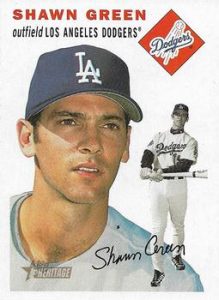
2003 Heritage (#THC99): “Shawn maintained his reputation as one of the game’s best power hitters in ’02. On May 23, he ripped a record-tying four home runs in one game. His mammoth day also included an MLB-record 19 total bases. The Dodger outfielder finished with more than 40 homers for the third time. Shawn’s 49 round trippers in ’01 stand as a franchise record.”
2003 Upper Deck Play Ball (#30): “For a single day, Shawn Green was the greatest hitter in baseball history. 5/23/2002 in Milwaukee, Green beat the Brewers all by himself, tying the Major League single-game record with four home runs and surpassing Joe Adcock’s 48-year-old record for total bases (18) with four homers as well as a double and a triple (19 total bases, 6-for-6, seven RBI, six runs scored!) Green is an All-Star on other days was well, batting 40-plus HR for the third time in his career in 2002.”
2004 Leaf Certified Materials (#176): “Green reached base five times in an 11-4 victory at San Diego on April 14, 2004, going 4-for-4 with four runs. The outfielder-turned-first baseman had two doubles to give him 304 extra-base hits with the Dodgers, moving him past Davey Lopes into ninth place in L.A history.”
2004 Finest (#8): “On May 23, the first anniversary of his epic 6-for-6/four home run game at the very same site, Green struck again with a big game in Milwaukee. This time, he went 3-for-5 with four RBI, three of which game via a seventh-inning longball that proved to be the game winner.”
After he was traded to the Diamondbacks and later to the Mets, the number of cards released changed. Reading the backs of the cards still showed that Shawn was a natural athlete and had the skills and ability to adapt to a new role with a new team. The cards showed that Shawn was a good player and a welcome addition to his new teams.
His time was short with the Diamondbacks.
Near the end of the 2006 season he was traded to the Mets and the 2006 Upper Deck (#1,120) included a picture of him in a New York uniform and reference to his first games as a Met. “The Mets geared up for a run at the NL pennant with the late-season addition of Green in 2006. He made a splash in his debut game in a New York uniform (8/24) when he had an RBI single in a 6-2 victory over the Cardinals.” 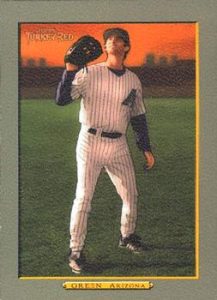
Topps 2006 Turkey Red (#318) provided a wonderful summary of his career: “Shawn advanced quickly through the Toronto organization and was only 21 years old when he played his last Minor League game as a .344 hitter for Syracuse in 1994. His power developed significantly during a five-year run with the Blue Jays to the point where he finished fifth in the American League with 42 home runs in 1999 – the year of his first All-Star Game selection. He also claimed an AL Gold Glove Award and a Silver Slugger Award that season. Traded to the Dodgers, he slammed 49 homers in 2001 and 42 in 2002. He moved to Arizona in 2005, and was traded to the Mets the following year.”
Finally, as a Dodger the first card was released referencing his Jewish heritage. The card in question was the 2002 Topps and the reference was “Until he took off for Yom Kippur on 9/26/01, Shawn had played in an MLB-high 415 straight games.”
There were other cards that referenced his support for Jewish causes such as the 2001 Gallery reference to “active with Jewish Federation” along with the 2002 Fleer (#98) reference “Shawn helps promote KOREH L.A., the Los Angeles Jewish Coalition for Literacy.”
I did not run across any Shawn Green cards that referenced Sandy Koufax, but did find a Max Fried 2011 team USA (#18u-7). “Max has studied Sandy Koufax for years, trying to figure out – and ultimately mimic – how the former Dodgers ace threw his curve.”
As Shawn approached Hank Greenberg’s career home runs, only the media tracked the event. I could not find any reference on cards.
In 1993 I had no insight into how long Shawn’s career would span and the total of cards that would be released. Like any hobby the journey was fun and I did connect to Shawn the baseball player.
If it was not for collecting Shawn, I never would not have experienced how card collecting had changed. While collecting Shawn I also enjoyed finding out about other Jewish players who appeared on their own cards.

